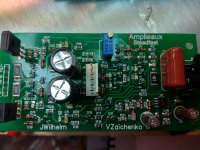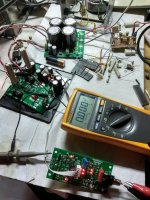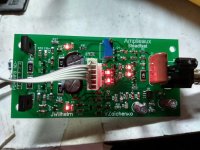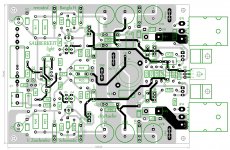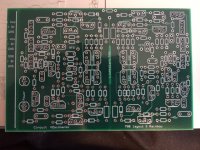A small correction to original schematic from post #1859 - R14, R16 must be shorted.
Doing so, we prevent the distortion from slightly increasing at high swings - it stays very low up to almost clipping.
What output stage module did you use here to get those low THD results?
Is it really required to have dual drivers for the OPS? I believe the beta of the OPS transistors are reasonable like 50 atleast? so just with 0.5Amps of output from the drivers the OPS current will be about 25amps? So considering even at full clipping at 80V at 4ohm the output current from the drivers seem quite sufficient? Arent there any instabilities issues with the dual drivers? Or would that increase THD?This is the OPS module.
Zobel / Thiele networks, protection circuitry, SS relays, binding posts are placed on the separate board. IPS modules are interchangeable - a good choice of front-ends for different applications and/or tastes is available.
Cheers,
Valery
What output stage module did you use here to get those low THD results?
Values in the initial post on the Lichtstark front-end were the result of a standalone simulation. However, being combined with NS OPS (or NS Double Power) this front-end is going to show very low distortion / high accuracy in every aspect. The main reason - the circuit is highly linear if you look at it open loop.
Plus it employs the current mode amplification. This is also important.
Last edited:
valery now im in more confused state of with feedback and without GNFB. I have heard the no GNFB amplifier before and regarding the THD figures. I dont know sonically how much do they contribute. Removing the frequency distortion are we introducing time distortion? I probably need to do an extensive listening.Values in the initial post on the Lichtstark front-end were the result of a standalone simulation. However, being combined with ND OPS (or NS Double Power) this front-end is going to show very low distortion / high accuracy in every aspect. The main reason - the circuit is highly linear if you look at it open loop.
Plus it employs the current mode amplification. This is also important.
Is it really required to have dual drivers for the OPS? I believe the beta of the OPS transistors are reasonable like 50 atleast? so just with 0.5Amps of output from the drivers the OPS current will be about 25amps? So considering even at full clipping at 80V at 4ohm the output current from the drivers seem quite sufficient? Arent there any instabilities issues with the dual drivers? Or would that increase THD?
The output current depends on the output voltage applied to the load.
The base current of the output transistors is "parasitic" component, depending on beta, which, in turn, degrades, depending on the output current and temperature.
This base current loads the drivers, right. But this is only one aspect. The other aspect you need to take into account is the input capacitance of the output transistors - rather high in ON Semi transistors we use (Cob = 600pF). With 3 output pairs (6 transistors), the total capacitance is 3600pF - very high. In order to preserve the open-loop OPS bandwidth, I use the 2-nd pair of drivers for driving the other 3 pairs of the output transistors.
Removing the frequency distortion are we introducing time distortion?
I'm not sure I understand this.
yesterday I tried to simulate a low open loop gain front end and applied little feedback as much as 6db and found that THD is rather higher like 0.14% on entire BW. Coming to the ODNF. When distortion alone is corrected with ODNF my question is isnt that same audio signal is being affected by the ODNF as it corrects only the distortion parameters in other word its more like same NFB concept but applied only to the distortion? If so what is the percentage of signal which is not affected.
yesterday I tried to simulate a low open loop gain front end and applied little feedback as much as 6db and found that THD is rather higher like 0.14% on entire BW.
Higher than what? Higher than the one with no NFB? Not possible.
Coming to the ODNF. When distortion alone is corrected with ODNF my question is isnt that same audio signal is being affected by the ODNF as it corrects only the distortion parameters in other word its more like same NFB concept but applied only to the distortion? If so what is the percentage of signal which is not affected.
In terms of the influence on the overall level of distortion, you can treat ODNF as a global feedback loop. It's arranged in a different way - an inverted error signal sums with the total signal (original + error) at the output of the front-end. In this case, the overall gain and bandwidth of the amplifier in unchanged, but the distortion is suppressed to the extent, proportional to the error signal / total signal ratio. In my particular case (Simpelstark+), ODNF loop gain is 18db.
Values in the initial post on the Lichtstark front-end were the result of a standalone simulation. However, being combined with NS OPS (or NS Double Power) this front-end is going to show very low distortion / high accuracy in every aspect. The main reason - the circuit is highly linear if you look at it open loop.
Plus it employs the current mode amplification. This is also important.
Very interesting!
Can you guide me on where to find the NS modules you suggest?
Link in my signature
Great!
Where are the schematics of the NS OPS Double Power?
That would work, wouldn't it?
Great!
Where are the schematics of the NS OPS Double Power?
That would work, wouldn't it?
You were asking this question recently, were you?
So I have attached the schematic to the post #2874.
I recommend using our boards as proper functioning of the OPS depends on certain layout nuances.
Cheers,
Valery
Hi Valery and Fellas.
Total out of actual discussion here.
As you showed the SAUBERKEIT schematic, any time back, in Light version i
have tried a One board compact version.
Today i have taken time to finish my routing job.
Are there any failure to discover?
Than i have to do rework for bettering.
Regards
Total out of actual discussion here.
As you showed the SAUBERKEIT schematic, any time back, in Light version i
have tried a One board compact version.
Today i have taken time to finish my routing job.
Are there any failure to discover?
Than i have to do rework for bettering.
Regards
Attachments
- Home
- Amplifiers
- Solid State
- Revisiting some "old" ideas from 1970's - IPS, OPS
